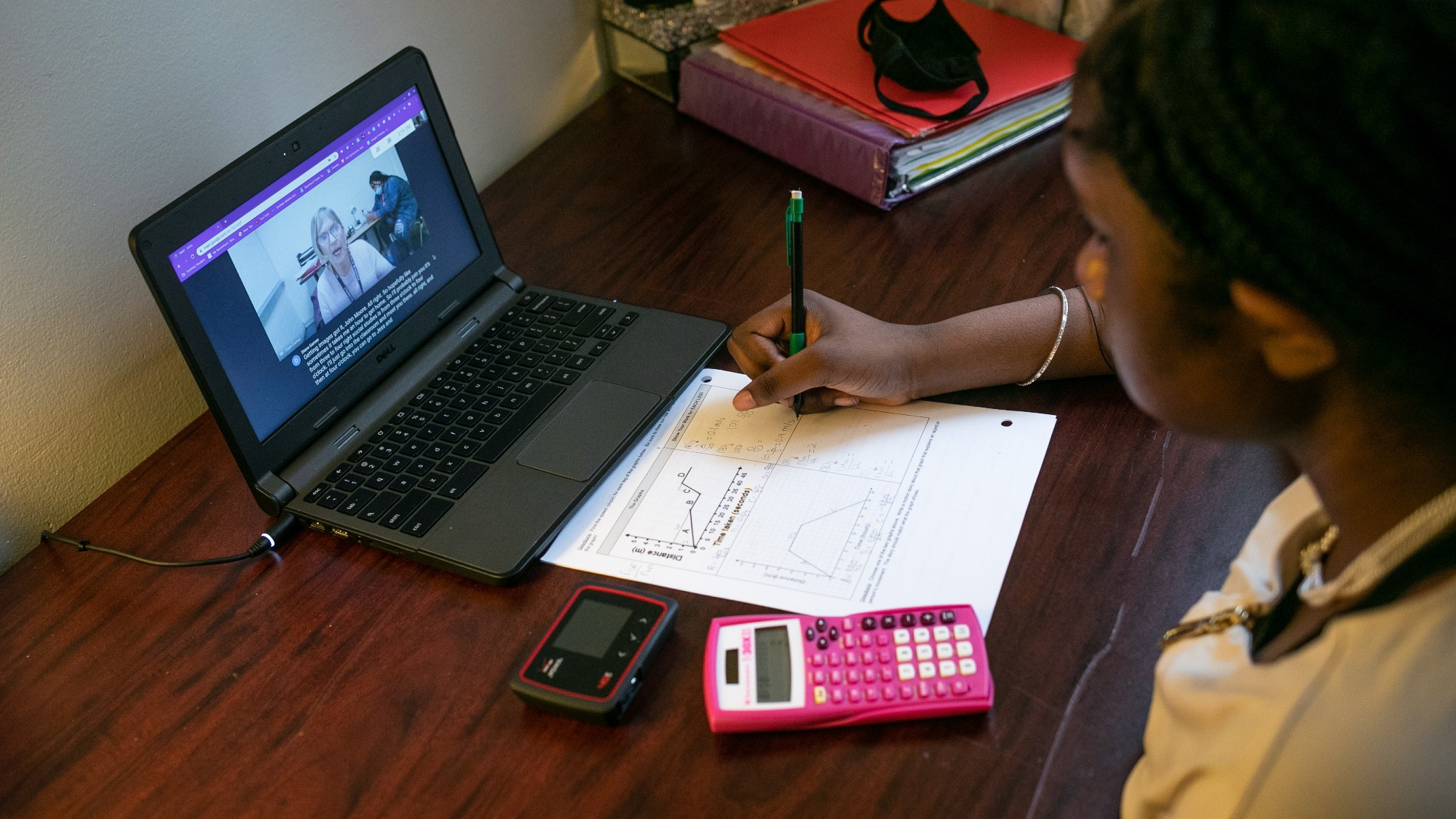

This article was originally published on Undark.
The transition to online learning in the United States during the Covid-19 pandemic was, by many accounts, a failure. While there were some bright spots across the country, the transition was messy and uneven—countless teachers had neither the materials nor training they needed to effectively connect with students remotely, while many of those students were bored, isolated, and lacked the resources they needed to learn. The results were abysmal: low test scores, fewer children learning at grade level, increased inequity, and teacher burnout. With the public health crisis on top of deaths and job losses in many families, students experienced increases in depression, anxiety, and suicide risk.
Yet society very well may face new widespread calamities in the near future, from another pandemic to extreme weather, that will require a similarly quick shift to remote school. Success will hinge on big changes, from infrastructure to teacher training, several experts told Undark. “We absolutely need to invest in ways for schools to run continuously, to pick up where they left off. But man, it’s a tall order,” said Heather L. Schwartz, a senior policy researcher at RAND. “It’s not good enough for teachers to simply refer students to disconnected, stand-alone videos on, say, YouTube. Students need lessons that connect directly to what they were learning before school closed.”
More than three years after U.S. schools shifted to remote instruction on an emergency basis, the education sector is still largely unprepared for another long-term interruption of in-person school. The stakes are highest for those who need it most: low-income children and students of color, who are also most likely to be harmed in a future pandemic or live in communities most affected by climate change. But, given the abundance of research on what didn’t work during the pandemic, school leaders may have the opportunity to do things differently next time. Being ready would require strategic planning, rethinking the role of the teacher, and using new technology wisely, experts told Undark. And many problems with remote learning actually trace back not to technology, but to basic instructional quality. Effective remote learning won’t happen if schools aren’t already employing best practices in the physical classroom, such as creating a culture of learning from mistakes, empowering teachers to meet individual student needs, establishing high expectations, and setting clear goals supported by frequent feedback. While it’s ambitious to envision that every school district will create seamless virtual learning platforms—and, for that matter, overcome challenges in education more broadly—the lessons of the pandemic are there to be followed or ignored.
“We haven’t done anywhere near the amount of planning or the development of the instructional infrastructure needed to allow for a smooth transition next time schools need to close for prolonged periods of time,” Schwartz said. “Until we can reach that goal, I don’t have high confidence that the next prolonged school closure will be substantially more successful.”
Before the pandemic, only 3 percent of U.S. school districts offered virtual school, mostly for students with unique circumstances, such as a disability or those intensely pursuing a sport or the performing arts, according to a RAND survey Schwartz co-authored. For the most part, the educational technology companies and developers creating software for these schools promised to give students a personalized experience. But the research on these programs, which focused on virtual charter schools that only existed online, showed poor outcomes. Their students were a year behind in math and nearly a half-year behind in reading, and courses offered less direct time with a teacher each week than regular schools have in a day.
The pandemic sparked growth in stand-alone virtual academies, in addition to the emergency remote learning that districts had to adopt in March 2020. Educators’ interest in online instructional materials exploded, too, according to Schwartz, “and it really put the foot on the gas to ramp them up, expand them, and in theory, improve them.” By June 2021, the number of school districts with a stand-alone virtual school rose to 26 percent. Of the remaining districts, another 23 percent were interested in offering an online school, the report found.
But the sheer magnitude of options for online learning didn’t necessarily mean it worked well, Schwartz said: “It’s the quality part that has to come up in order for this to be a really good, viable alternative to in person instruction.” And individualized, self-directed online learning proved to be a pipe dream—especially for younger children who needed support from a parent or other family member even to get online, much less stay focused.
“The notion that students would have personalized playlists and could curate their own education was proven to be problematic on a couple levels, especially for younger and less affluent students,” said Thomas Toch, director of FutureEd, an education think tank at Georgetown University’s McCourt School of Public Policy. “The social and emotional toll that isolation and those traumas took on students suggest that the social dimension of schooling is hugely important and was greatly undervalued, especially by proponents for an increased role of technology.”
Students also often didn’t have the materials they needed for online school, some lacking computers or internet access at home. Teachers didn’t have the right training for online instruction, which has a unique pedagogy and best practices. As a result, many virtual classrooms attempted to replicate the same lessons over video that would’ve been delivered at school. The results were overwhelmingly bad, research shows. For example, a 2022 study found six consistent themes about how the pandemic affected learning, including a lack of interaction between students and with teachers, and disproportionate harm to low-income students. Numb from isolation and too many hours in front of a screen, students failed to engage in coursework and suffered emotionally.
After some districts resumed in-person or hybrid instruction in the 2020 fall semester, it became clear that the longer students were remote, the worse their learning delays. For example, national standardized test scores for the 2020-2021 school year showed that passing rates for math declined about 14 percentage points on average, more than three times the drop seen in districts that returned to in-person instruction the earliest, according to a 2021 National Bureau of Economic Research study. Even after most U.S. districts resumed in-person instruction, students who had been online the longest continued to lag behind their peers. The pandemic hit cities hardest and the effects disproportionately harmed low-income children and students of color in urban areas.
“What we did during the pandemic is not the optimal use of online learning in education for the future,” said Ashley Jochim, a researcher at the Center on Reinventing Public Education at Arizona State University’s Mary Lou Fulton Teachers College. “Online learning is not a full stop substitute for what kids need to thrive and be supported at school.”
Children also largely prefer in-person school. A 2022 Pew Research Center survey suggested that 65 percent of students would rather be in a classroom, 9 percent would opt for online only, and the rest are unsure or prefer a hybrid model. “For most families and kids, full-time online school is actually not the educational solution they want,” Jochim said.
Virtual school felt meaningless to Abner Magdaleno, a 12th grader in Los Angeles. “I couldn’t really connect with it, because I’m more of, like, a social person. And that was stripped away from me when we went online,” recalled Magdaleno. Mackenzie Sheehy, 19, of Fond du Lac, Wisconsin, found there were too many distractions at home to learn. Her grades suffered, and she missed the one-on-one time with teachers. (Sheehy graduated from high school in 2022.)
Many teachers feel the same way. “Nothing replaces physical proximity, whatever the age,” said Ana Silva, a New York City English teacher. She enjoyed experimenting with interactive technology during online school, but is grateful to be back in person. “I like the casual way kids can come to my desk and see me. I like the dynamism—seeing kids in the cafeteria. Those interactions are really positive, and they were entirely missing during the online learning.”
During the 2022-2023 school year, many districts initially planned to continue online courses for snow days and other building closures. But they found that the teacher instruction, student experience, and demands on families were simply too different for in-person versus remote school, said Liz Kolb, an associate professor in the School of Education at the University of Michigan. “Schools are moving away from that because it’s too difficult to quickly transition and blend back and forth among the two without having strong structures in place,” Kolb said. “Most schools don’t have those strong structures.”
In addition, both families and educators grew sick of their screens. “They’re trying to avoid technology a little bit. There’s this fatigue coming out of remote learning and the pandemic,” said Mingyu Feng, a research director at WestEd, a nonprofit research agency. “If the students are on Zoom every day for like, six hours, that seems to be not quite right.”
Despite the bumpy pandemic rollout, online school can serve an important role in the U.S. education system. For one, online learning is a better alternative for some students. Garvey Mortley, 15, of Bethesda, Maryland, and her two sisters all switched to their district’s virtual academy during the pandemic to protect their own health and their grandmother’s. This year, Mortley’s sisters went back to in-person school, but she chose to stay online. “I love the flexibility about it,” she said, noting that some of her classmates prefer it because they have a disability or have demanding schedules. “I love how I can just roll out of bed in the morning, and I can sit down and do school.” Some educators also prefer teaching online, according to reports of virtual schools that were inundated with applications from teachers because they wanted to keep working from home. Silva, the New York high school English teacher, enjoys online tutoring and academic coaching, because it facilitates one-on-one interaction.
And in rural districts and those with low enrollment, some access to online learning ensures students can take courses that could otherwise be inaccessible. “Because of the economies of scale in small rural districts, they needed to tap into online and shared service delivery arrangements in order to provide a full complement of coursework at the high school level,” said Jochim. Innovation in these districts, she added, will accelerate: “We’ll continue to see growth, scalability, and improvement in quality.”
There were also some schools that were largely successful at switching to online at the start of the pandemic, such as Vista Unified School District in California, which pooled and shared innovative ideas for adapting in March 2020; the school quickly put together an online portal so that principals and teachers could share ideas and the district could allot the necessary resources. Digging into examples like this could point the way to the future of online learning, said Chelsea Waite, a senior researcher at the Center on Reinventing Public Education, who was part of a collaborative project studying 70 schools and districts that pivoted successfully to online learning. The project found three factors that made the transition work: a focus on resilience, collaboration, and autonomy for both students and educators; a healthy culture that prioritized relationships; and strong yet flexible systems that were accustomed to adaptation.
“We investigated schools that did seem to be more prepared for the Covid disruption, not just with having devices in students’ hands or having an online curriculum already, but with a learning culture in the school that really prioritized agency and problem solving as skills for students and adults,” Waite said. “In these schools, kids are learning from a very young age to be a little bit more self-directed, to set goals, and pursue them and pivot when they need to.”
Similarly, many of the takeaways from the pandemic trace back to the basics of effective education, not technological innovation. A landmark report by the National Academies of Sciences called “How People Learn,” most recently updated in 2018, synthesized the body of educational research and identified four key features in the most successful learning environments. First, these schools are designed for, and adapt to, the specific students, building on what they bring to the classroom, such as skills and beliefs. Second, successful schools give their students clear goals, showing them what they need to learn and how they can get there. Third, they provide in-the-moment feedback that emphasizes understanding, not memorization. And finally, the most successful schools are community-centered, with a culture of collaboration and acceptance of mistakes.
“We as humans are social learners, yet some of the tech talk is driven by people who are strong individual learners,” said Jeremy Roschelle, executive director of Learning Sciences Research at Digital Promise, a global education nonprofit. “They’re not necessarily thinking about how most people learn, which is very social.”
Another powerful insight from pandemic-era remote schooling involves the evolving role of teachers, said Kim Kelly, a middle school math teacher at Northbridge Middle School in Massachusetts and a K-8 curriculum coach. Historically, a teacher’s role is the keeper of knowledge who delivers instruction. But in recent years, there has been a shift in approach, where teachers think of themselves as coaches who can intervene based on a student’s individual learning progress. Technology that assists with a coach-like role can be effective—but requires educators to be trained and comfortable interpreting data on student needs.
For example, with a digital learning platform called ASSISTments, teachers can assign math problems, students complete them—potentially receiving in-the-moment feedback on steps they’re getting wrong—and then the teachers can use data from individual students and the entire class to plan instruction and see where additional support is needed.
“A big advantage of these computer-driven products is they really try to diagnose where students are, and try to address their needs. It’s very personalized, individualized,” said WestEd’s Feng, who has evaluated ASSISTments and other educational technologies. She noted that some teachers feel frustrated “when you expect them to read the data and try to figure out what the students’ needs are.”
Teacher’s colleges don’t typically prepare educators to interpret data and change their practices, said Kelly, whose dissertation focused on self-regulated online learning. But professional development has helped her learn to harness technology to improve teaching and learning. “Schools are in data overload; we are oozing data from every direction, yet none of it is very actionable,” she said. Some technology, she added, provided student data that she could use regularly, which changed how she taught and assigned homework.
When students get feedback from the computer program during a homework session, the whole class doesn’t have to review the homework together, which can save time. Educators can move forward on instruction—or if they see areas of confusion, focus more on those topics. The ability of the programs to detect how well students are learning “is unreal,” said Kelly, “but it really does require teachers to be monitoring that data and interpreting.” She learned to accept that some students could drive their own learning and act on the feedback from homework, while others simply needed more teacher intervention. She now does more assessment at the beginning of a course to better support all students.
At the district or even national level, letting teachers play to their strengths can also help improve how their students learn, Toch, of FutureEd, said. For example, if a teacher is better at delivering instruction, they could give a lesson to a larger group of students online, while another teacher who is more comfortable in the coach role could work in smaller groups or one-on-one.
“One thing we saw during the pandemic are smart strategies for using technology to get outstanding teachers in front of more students,” Toch said, describing one effort that recruited exceptional teachers nationally and built a strong curriculum to be delivered online. “The local educators were providing support for their students in their classrooms.”
Remote schooling requires new technology, and already, educators are swamped with competing platforms and software choices—most of which have insufficient evidence of efficacy. Traditional independent research on specific technologies is sparse, Roschelle said. Post-pandemic, the field is so diverse and there are so many technologies in use, it’s almost impossible to find a control group to design a randomized control trial, he added. However, there is qualitative research and evidence that give hints about the quality of technology and online learning, such as case studies and school recommendations.
Educational leaders should ask three key questions about technology before investing, recommended Ryan Baker, a professor of education at the University of Pennsylvania: Is there evidence it works to improve learning outcomes? Does the vendor provide support and training, or are teachers on their own? And does it work with the same types of students as are in their school or district? In other words, educators must look at a technology’s track record in the context of their own school’s demographics, geography, culture, and challenges. These decisions are complicated by the small universe of researchers and evaluators, who have many overlapping relationships. (Over his career, for example, Baker has worked with or consulted for many of the education technology firms that create the software he studies.)
It may help to broaden the definition of evidence. The Center on Reinventing Public Education launched the Canopy project to collect examples of effective educational innovation around the U.S.
“What we wanted to do is build much better and more open and collective knowledge about where schools are challenging old assumptions and redesigning what school is and should be,” she added, noting that these educational leaders are reconceptualizing the skills they want students to attain. “They’re often trying to measure or communicate concepts that we don’t have great measurement tools for yet. So they end up relying on a lot of testimonials and evidence of student work.”
The moment is ripe for innovation in online and in-person education, said Julia Fallon, executive director of the State Educational Technology Directors Association, since the pandemic accelerated the rollout of devices and needed infrastructure. There’s an opportunity and need for technology that empowers teachers to improve learning outcomes and work more efficiently, said Roschelle. Online and hybrid learning are clearly here to stay—and likely will be called upon again during future temporary school closures.
Still, poorly-executed remote learning risks tainting the whole model; parents and students may be unlikely to give it a second chance. The pandemic showed the hard and fast limits on the potential for fully remote learning to be adopted broadly, for one, because in many communities, schools serve more than an educational function—they support children’s mental health, social needs, and nutrition and other physical health needs. The pandemic also highlighted the real challenge in training the entire U.S. teaching corps to be proficient in technology and data analysis. And the lack of a nimble shift to remote learning in an emergency will disproportionately harm low-income children and students of color. So the stakes are high for getting it right, experts told Undark, and summoning the political will.
“There are these benefits in online education, but there are also these real weaknesses we know from prior research and experience,” Jochim said. “So how do we build a system that has online learning as a complement to this other set of supports and experiences that kids benefit from?”
Katherine Reynolds Lewis is an award-winning journalist covering children, race, gender, disability, mental health, social justice, and science.
This article was originally published on Undark. Read the original article.
























